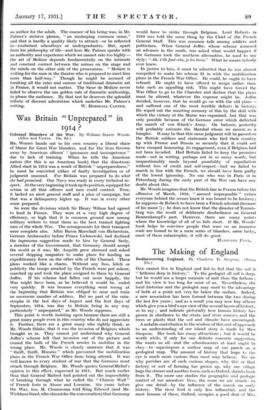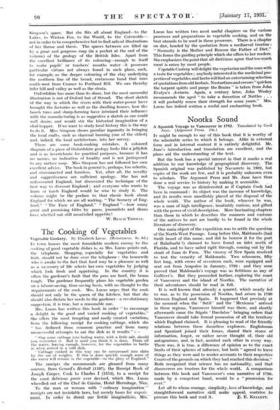The Making of England
Rediscovering England. By Charlotte D. Simpson. (Bonn; 21s.) ONE cannot live in England and fail to feel that the soil is "fathoms deep in history." To the geologist all soil is deep, but he would use a larger measure of unit than the fathom ; and his view is too long for most of us. Nevertheless, the local historian and the geologist may meet to the advantage of both at a point not very far below the surface. Indeed, a new association has been formed between the two during the last few years ; and as a result you may now buy atlases which give you a bird's-eye view of the several layers of history, so to say ; and indicate pictorially how human history has grown in obedience to the strata and river courses, and the trees or plants that the soil and climate have encouraged.
A notable contribution to the wisdom of this sort of approach to an understanding of our island story is made by Miss Simpson. Her book has many attractions ; but it would. be worth while, if only for one definite concrete suggestion. She wants us all—and the schoolmasters at least ought to obey—to superimpose a surface map of our parish on a geological map. The amount of history that leaps to the eye is much more various than most may believe. We sec why parishes arc of such curious shapes, why this or that factory or sort of farming has grown up, why one village hugs the stream and another town, such as Oxford, shrinks back from it. The more one studies the geographic and geologic 'control of our ancestors' lives, the more we arc struck—to -give one detail—by the influence of the niarsh on early history. The river- ford is only less influential, and the most famous of these, Oxford, occupies a good deal of Miss Simpson's space: But she flits all about England—to the Lakes, to Wieken Fen, to the Weald, to the Cotswolds— not in order to be comprehensive but to find salient illustrations of her theme and thesis. The spaces between are filled up by a great and gorgeous map (in a pocket at the end of the volume) of the geology of the British Isles. Apart from the excellent brilliance of its colouring—enough in itself to make pupils' or teachers' mouths water—it possesses particular virtues not always found in such plans, such, for example, as the deeper colouring of the clay underlying the northern line of the broad, cretaceous band that runs south-west from Cromer to Portland Bill. We can thereby infer hill and valley as well as the strata.
Oxfordshire has more than its share, but the most successful illustration is not of Oxford but of Stroud. The short sketch of the way in which the rivers with their water-power have brought the factories as well as the dwelling houses, how the beech trees and sheep-farming have intwined their influence with the manufacturing is as suggestive a sketch as one could well desire, and would stir the historical imagination of a clod-hopper. If we want to study local history this is the way to do it. Miss Simpson shows peculiar ingenuity in bringing the local crafts, such as charcoal burning (one of the oldest) and, indeed, the local architecture, into her survey.
There are some book-making mistakes. A coloured diagram of a piece of Oxfordshire geology looks like a jellyfish and is as invertebrate for practical purposes, because it has no names, no indication of locality and is not juxtaposed to any surface map. Miss Simpson has not followed her own excellent advice. The book in general is, perhaps, too eclectic, and disconnected and formless. Yet, after all, the novelty and suggestiveness are . sufficient apology. She has not rediscovered England, but discovered the technique of the best way to discover England ; and everyone who wants to learn or teach England would be wise to study it. The volume might be the preface to that classic book about England for which we are all waiting, "The Scenery of Eng- land," "The Face of England," "England "—how many great and promising titles by peers, journalists and deans have whetted out still unsatisfied appetite
W. BEACH THOMAS.





































 Previous page
Previous page